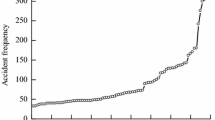Abstract
Numbers of road accidents are increasing day by day and it is necessary to keep record of all these accidents, for the purpose of providing road safety. The records maintained by the police might have some inaccurate data. For this purpose, different authors have proposed different techniques, in which the accidents are mapped to the correct road segment. The existing accident mapping algorithms have many limitations such as (1) algorithms developed are for the specific datasets only, (2) improper mapping in case of complex road networks and (3) modular approach is used for different types of roads, instead of any general rule to be applied, (4) learning algorithm developed involve lot of cost and efforts, without guaranteeing the mapping of accident to the exact location. The challenge is to identify this inaccuracy in data and correct it with least amount of cost and effort involved. Significance of the attributes having inaccuracy plays an important role in mapping accidents to the correct location. In this paper, our main aim is to (1) map the accidents on the correct location, (2) finding missing values, (3) calculation of the erroneous values in police recorded data and (4) estimation of the attribute significance. The proposed algorithm can map the accidents to correct location instead of mapping an accident to a road segment, junction, and candidate link. The basic concern is that the algorithm being developed should be generalized and can be applied on any type of a road network. To achieve this aim, we have proposed the minimum bounded region based tree technique, which used for pattern matching methodology.















Similar content being viewed by others
References
National Crime Records Bureau (NCRB) (2013) Accidental deaths and suicides in India Report http://ncrb.gov.in/StatPublications/ADSI/ADSI2013/ADSI-2013.pdf
Jayan KD, Ganeshkumar B (2010) Identification of accident hot spots: a GIS based implementation for Kannur district, Kerala. Int J Geomat Geosci 1(1):51–59
Leon DRM, Doroy N, Lidasan H, Castro J (2013) Black spot cluster analysis of motorcycle accidents. In: Proceedings of the Eastern Asia society for transportation studies, vol 9, pp P369 (1–14)
Chen H (2012) Black spot determination of traffic accident locations and its spatial association characteristic analysis based on GIS. J Geograph Inf Syst 4(6):608–617
Ogwueleka NF, Misra S, Chibueze O, Sanz FL (2014) An artificial neural network model for road accident prediction: a case study of a developing country. Acta Polytech Hung 11(5):177–197
Zhang S, Qin Z, Ling XC, Sheng S (2005) Missing is useful: missing values in cost-sensitive decision trees. IEEE Trans Knowl Data Eng 17(12):1689–1693
Rahman MM, Davis ND (2013) Machine learning based missing value imputation method for clinical dataset. IAENG Trans Eng Technol 229:245–257
Sharma A, Mehta N, Sharma I (2013) Reasoning with missing values in multi attribute datasets. Int J Adv Res Comput Sci Softw Eng 3(5):1035–1043
Minakshi Vohra R, Gimpy M (2014) Missing value imputation in multi attribute data set. Int J Comput Sci Inf Technol 5(4):5315–5321
Somasundaram SR, Nedunchezhian R (2012) Missing value imputation using refined mean substitution. Int J Comput Sci Issues 9(4):306–313
Mehala B, Thangaiah JRP, Vivekanandan K (2009) Selecting scalable algorithms to deal with missing values. Int J Recent Trends Eng 1(2):80–83
Poolsawad N, Kambhampati C, Cleland FGJ (2011) Feature selection approaches with missing values handling for data mining—a case study of heart failure dataset. Int J Biomed Biol Eng 5(12):531–540
Singh N, Chabra S, Javeed A, Kumar P (2015) Missing value imputation with unsupervised kohonen self organizing map. International conference on emerging research in computing, information, communication and applications. Springer, New Delhi, pp 61–76
Chaudhuri D, Chaudhuri BB (1991) Elliptic and circular fit of a two-tone image and their 3-D extensions. Assoc Adv Model Simul Tech Enterp Rev 15(4):15–36
Deka L, Quddus M (2014) Network-level accident-mapping: distance based pattern matching using artificial neural network. Accid Anal Prev 65:105–113
Author information
Authors and Affiliations
Corresponding author
Rights and permissions
About this article
Cite this article
Kumar, A., Johari, S., Proch, D. et al. A Tree Based Approach for Data Pre-processing and Pattern Matching for Accident Mapping on Road Networks. Proc. Natl. Acad. Sci., India, Sect. A Phys. Sci. 89, 453–466 (2019). https://doi.org/10.1007/s40010-018-0495-5
Received:
Revised:
Accepted:
Published:
Issue Date:
DOI: https://doi.org/10.1007/s40010-018-0495-5




